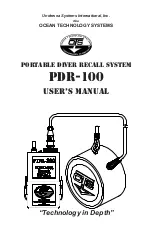
Section 3. CR5000 Measurement Details
3-3
3.1.4 SettlingTime
When the CR5000 switches to a new channel or switches on the excitation for
a bridge measurement, there is a finite amount of time required for the signal to
reach its true value. Delaying between setting up a measurement (switching to
the channel, setting the excitation) and making the measurement allows the
signal to settle to the correct value. The default settling times are the
minimum required for the CR5000 to settle to within its accuracy
specifications. Additional time is necessary when working with high sensor
resistances or long lead lengths (higher capacitance). Using a longer settling
time increases the time required for each measurement. Section 3.3 goes into
more detail on determining an adequate settling time.
When the CR5000 Reverses the differential input or the excitation polarity it
delays the same settling time after the reversal as it does before the first
measurement. Thus there are two delays per channel when either RevDiff or
RevEx is used. If both RevDiff and RevEx are selected, there are four
measurement segments, positive and negative excitations with the inputs one
way and positive and negative excitations with the inputs reversed. The
CR5000 switches to the channel:
sets the excitation, delays, measures,
reverses the excitation, delays, measures,
reverses the excitation, reverses the inputs, delays, measures,
reverses the excitation, delays, measures.
Thus there are four delays per channel measured. The CR5000 processes the
measurement segments into the single value it returns for the measurement.
3.1.5 Integration
Integration is used to reduce the noise included in a measurement. The CR5000
may use a combination of analog and digital integration.
For the fastest measurements, there is a zero integration measurement. This
measurement does not integrate. The signal at a precise instant is sampled and
this voltage is held for A/D conversion.
With analog integration, the input signal is integrated for a precise period of
time. The integrated value is held for the A/D conversion. There are three
possible analog integration times 20 ms, 16.67 ms and 250 µs. The 20 ms
(1/50 second) and 16.667 ms (1/60 second) are available to integrate out the
effects of noise from 50 or 60 Hz AC power sources.
An integration time in microseconds is specified as part of the measurement
instruction. An integration time of 0 selects the sample-and-hold, 250 selects
the 250 µs integration, 16667 or “ _60 Hz” selects the 60 Hz rejection
(16667 µs), and 20000 or “ _50 Hz” selects 50 Hz rejection (20000 µs).
In addition to the analog integrations, it is possible to average a number of the
sample-and-hold or 250 µs integration measurements. The A/D conversions
are made as rapidly as possible: every 100 µs for the samples and every 500 µs
for the 250 µs integrations. If the integration time specified is 250 µs or a
Содержание CR5000
Страница 39: ...Section 1 Installation and Maintenance 1 15 S A N Y O FIGURE 1 11 6 Removal of band clamp and battery ...
Страница 40: ...Section 1 Installation and Maintenance 1 16 This is a blank page ...
Страница 54: ...Section 2 Data Storage and Retrieval 2 14 This is a blank page ...
Страница 88: ...Section 4 CRBasic Native Language Programming 4 12 This is a blank page ...
Страница 94: ...Section 5 Program Declarations 5 6 This is a blank page ...
Страница 172: ...Section 7 Measurement Instructions 7 46 This is a blank page ...
Страница 206: ......
Страница 236: ...Index Index 4 This is a blank page ...
Страница 237: ...This is a blank page ...
















































